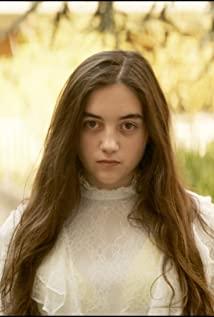Portrait of a Burning Woman Portrait de la jeune fille en feu
(2019 France 120 minutes)
Director/Screenwriter: Celine Sciamma
Starring: Adela Harnell, Noemi Melant, Luanna Bajrami
Main awards: Best Screenplay Award at the 72nd Cannes Film Festival
I am very fortunate that "Portrait of a Burning Woman" can appear in the screening list "Voice of Women" at the Beijing Film Festival, and I am even more honored to see Burning Woman on the domestic big screen. Recalling the 120 minutes of complicated emotions intertwined in the China Film Archive that night, the scenes that have appeared in my dreams countless times really occupied all the field of vision, the clear waves rolling and the roar of the burning flames felt that everything was within reach. And, the rich picture details and subtle light and shadow create the effect of oil painting texture. As time goes by, one by one unreservedly spreads out in front of you; the use of classical love stories throughout will trigger thinking and silence about life, memory and existence. . In the theater, we can clearly perceive every nuanced emotional undercurrent, the two-way and equal affectionate gaze that is so intense that it is suffocating, the longing and the unrepentant pursuit, the short-lived blazing heat will be burnt as you go along. The pain keeps burning, and eventually everything goes by with the passage of time, only silence and acceptance are right; after this, the loneliness and the unbearable madness and madness that go deep into the bone marrow are accepted and accepted in the long and extremely night life, because human beings themselves Weakness, the damaged parts left by the burns gradually heal with the impetus of time, and eventually leave scars of different shapes; but we still live in this world and feel our existence because the past will still leave A group of fire that will never go out is always like a shadow, leaving a weak but strong enough torch to resist and survive in the long night, burning brightly in all the moments of indifference and every loneliness, telling you that your own existence is warm, Tell you that you have come to this world in vain, and then you will continue to live with the memory.
I still underestimated the popularity of Burning Girls at the Beijing Film Festival, but fortunately, after many setbacks, I was able to get a seat in the first row. Bai), but it was still the best movie viewing experience I’ve ever had, and every screening of Burning Girls has fans spontaneously supporting activities, and some cards or ticket holders will be distributed in advance on the spot. Compared with watching in theaters, at least a quarter of the details of the picture and sound are ignored when watching on the computer in the past. Many people say that the rhythm is slow and calm like water, but whether it is the details of the picture, the emotional expression or the language of the shots, they are all subtle and just right. All the subtle but rich details are like the melody flowing inside an oil painting that can only be captured with the eyes (personal). I feel that this kind of flowing melody can be better reflected in the paintings of Expressionism and Post-Impressionism), the rhythm of the film is not slow (I hoped it could be slower at the time..); there is no background music inserted in the whole film, except for Marianne's performance, It is the climax part of a rising vocal singing and the ending part of Vivaldi's "Four Seasons" Xia Violin Concerto (really two extraordinary pieces), which makes the audience's emotions not carried away by the background music but real Touched by the images and emotions in front of me, it is undeniable that the importance of the soundtrack of the film is undeniable, but sometimes I feel that I deliberately use the soundtrack to let the audience know when it is time to be moved and cry, just like in some Spring Festival Gala sketches, the sensational part immediately cuts to the stage. The scene where the audience wipes their tears; when I watch Burning Girl, I feel like I have regained control over my emotions.
Although most of the audience of the Beijing Film Festival are locals, there are still many fans who come to live in Beijing from all over the world in order to watch movies. In the process of going to and from different theaters, they fight against the traffic that can drive people crazy in Beijing. Although family members Even the security guards at the entrance of the museum could not understand. But good movies still have to go back to the theater to watch, aside from the "sacred sense of ritual", grab/buy tickets and the excitement before watching the movie, stare at the theater, hold your breath, concentrate fully, put down your defenses, expose your body and mind The moment is the most essential joy of watching a movie, and being infatuated with a certain thing, a certain Chinese culture, or a certain person is a rare and precious state in life.
The portrait of the woman on fire highlights the equal gaze as a lover, but it is unequal for a woman to look one way or both ways at many moments. I want to start with the example of painter Edgar Degas, who was obsessed with drawing ballet dancers. He left two thousand works in his lifetime, half of which were ballerinas. Dance has a sculptural beauty of the ultimate fluidity, and Degas found in the ballet dancer an image that would represent the perfect human body. The dancers in "The Dancing Girl on the Stage" are elegant and stretched, and the picture is like a dream; but the man in the suit with only half of his body on the upper right breaks this beauty. As the gold master, he dominates the power of viewing, because the 18th century Of the female ballet dancers from the bottom, the fastest way to get promoted is to get the appreciation and money ability of the sponsors. Special dance floors and viewing platforms are specially set up for dancers to show their gestures and the sponsors to judge and choose. In the painting, the men in suits watch the dancers, the painter and the audience watch the dancers, and we watch the dancers through the painter. This keyhole angle is a question of viewing power that Degas wants to express. The dancers in the painting and the dancers in the 18th century reality are a dominated group without individual characteristics, showing and creating beauty is at the same time a deep contradiction and cruelty, and the female characters in many works are as A symbol of beauty that satisfies the audience's desire to peep (named "Memoirs of a Geisha"), and many people in real life are content to be a symbol of beauty.
(Photo source "Dahua History of Western Art" has a reddish color difference)
Returning to the portrait of the burning woman, the painter before Marianne and Eloise formed an unequal viewing relationship between the painter and the model. The painter dominated, and the model was the object of the painter's manipulation. Being a model is hard work, I rarely last for 20 minutes but a professional model can last for more than two hours.. This kind of dominated relationship makes Eloise feel unequal, so he refuses to pose, showing it as Some of the painted brushstrokes are scribbled and blunt, and the part of the face is smeared at will. It can be seen that the artist was really angry because he lost control when he painted... Marianne mistakenly used a candle to light it while observing the scribbled strokes of the previous artist. Painting, also a painter, she can naturally feel the mood of the artist at that time from the painting, and then simply burn it down, on the one hand, it is because of her disapproval and helplessness against this unequal perspective.
Equal perspectives are rarely or possibly absolutely non-existent in real life because people are born unequal, and gender inequality is only one factor. The struggle for relative equality can lead to a never-ending cycle of disappointment, or finding a home in a beautiful vision, or a momentary ephemeral that will be missed forever. In order to achieve the equal gaze between the two of them, Celine Sciamma deliberately restrained and prolonged the emotional rhythm, advancing the love step by step and then slowly burning it; even delayed the appearance and appearance of Eloise. , from the maid's ignorance, the mother's words and the sister's suicide to give the audience an initial impression of Eloise and her family, as well as the state of society and the fate of women throughout the 18th century, the tragic tone such as The "background music" continued from the beginning of the movie to the end of "Xia"; and when the maid came with the green skirt, the feet that were exposed at the bottom of the skirt made the audience feel that the hostess was about to appear. After moving up, there is a feeling of disappointment, the small design here is very interesting... And the real she is not much of her own clothes, longing for equality all year round in the monastery, relying on music and short-term freedom to escape from the future fearful man.
"When you look at the person in the painting, who am I looking at?"
At this moment, they have reached a short-lived but very valuable state, two-way and equal gaze, joyful observation, equal emotional flow... The whole process of painting got rid of one-way objective description and entered a kind of mutual communication mode; no one knows or cares about when the brush will stop forever, just stay and enjoy the space left for them to communicate and get along in the name of portrait painting; everything becomes simple and simple, and the world is left in front of you All the helplessness and anger that seem to be innate in the painting and the people who paint it have returned to peace.
"When you have no good reason to say anything, you will nod your head and support your forehead; when you are embarrassed, you will raise your eyebrows lightly; when you are embarrassed, you will gasp for breath."
"Portrait of a Lady on Fire" borrows the story of the singer Orpheus and his wife Eurydice in Greek mythology to suggest the direction of the plot. His wife Eurydice was killed by a poisonous snake shortly after their wedding, and Orpheus was so heartbroken that he went to the underworld to pray for his wife's soul. He moved the entire underworld with his singing, so the master agreed to Orpheus to bring his wife back to the world, but on the condition that he was not allowed to look back at her before leaving the valley. When Orpheus touched the door of the world, he wanted to know Whether his wife was following behind, he couldn't help but look back.
"At this moment she slipped into the abyss again, and he hurriedly stretched out his arms in an attempt to embrace his wife, but the unfortunate one caught only the backward airflow. And once again, caught by death, she had no complaints against her husband, complained What? Love her too much?"
"Going back is the choice he made, he chose to remember Eurydice, that's why he turned back."
"What he did was not the choice of the lover, but the choice of the poet."
"Maybe she said 'turn back' to him."
Unrelated, this story reminds me of one of the dialogues in "Chao Wen Dao": "Izumi, do you still remember that cold morning in Hokkaido? You said that you want to go out and test whether I really love you, you ask me , what should I do if your face is burnt out of sight in the fire? I said that I will accompany you faithfully for the rest of your life. You are disappointed to hear this answer, saying that I do not really love you, if If I really love you, I will blind myself and keep a beautiful spring in my heart forever."
The myth of Orpheus has a strong sense of tragic beauty. The maid felt angry and inexplicable for Eurydice, and felt that all his previous efforts were in vain; Marianne thought that the action of turning back was out of self-selection, The nature of poetry is chosen. Orpheus chose to remember, to keep all the short-lived and warm beauty of the newly married in his memory forever, because everything has changed since his wife became an unconscious, lame ghost in the underworld, and his wife is no longer beautiful and perfect. , she always carries the shadow of the viper and the underworld in her heart, the beautiful entity is saturated with the consciousness of death in the eternal darkness; we are all thrown into this world, but death is a fixed and arranged ending, And no one cares whether Eurydice is willing to return to the world, what lovers need is affection, affection is not a mistake, so he has never been at fault, Orpheus' affection has always existed, and what Eurydice needs is Rest and forget.
The myth tells the audience all the answers, so there's no need to delve into why Eloise didn't fight to be with Marianne after the film, and why Marianne didn't cry out for Eloise in the theater many years later. Because the end of the rebellion is doomed, Marianne chose the poet's memory. During the time on the isolated island, all the passion and enthusiasm were created by the shortness of getting along and the suffering shared by them. For them, this emotion and memory has become the wish of immortality in the exhausted life in the future. That is to say, if there are no setbacks and ups and downs, no heart-piercing torment, no indifference and loneliness that can strike anytime, anywhere, no deception, abandonment, disappointment, and forgetfulness, when understanding and happiness come, it will be too fulfilling and peaceful. The smooth dilutes the passion and blocks the imagination; without these, the gain is mediocre comfort, not happiness; it is not as indispensable as air and water, but it is the gift of fate, endowed with existence, memory, death, aria, wonderful , pursuit, burning and other words have unique meanings.
"Do all the people who fall in love think it's a novel experience"
"In every long night that waits for you"
"I imagine every move in a lover's room"
"Did you dream of me?"
"No need to dream"
"I miss you all the time"
- "Portrait of a Lady on Fire"
Ovid 54.5 In less than an hour, a flower as bright red as a pomegranate flower congealed. Before long, the wind that made her bloom again blew, and she withered again.
- "Portrait of a Lady on Fire" (page 28 of the book)
At the end of the film, Marianne sees the portrait of Eloise, the book in her hand is mottled and perhaps the paintings on the pages are blurred, but her finger is still pointing to page 28. The moments of separation in the past are many days of death in her life. In one of them, the daughter around her cannot represent her expectations for the future, but instead heralds another reincarnation; such as Eloise's mother: I can understand her, but I can't help her. Marianne said I had come out, but her students were still showing her sadness in the paintings. For people who are addicted to the past, they can really empathize at this moment, and they can express sympathy, but there is no need to blame.
The film ends with a 146-second long shot accompanied by the intense summer of Vivaldi's "Four Seasons". I don't know how to say this ending. It's really amazing. Personally, I feel that if the "eyes have not intersected" is placed at the end of the music, it's shady. part of the feeling will be stronger. The whole "Portrait of a Burning Woman" is as warm as the title, just like this "Summer", when you clumsily play a symphony that I have never heard and can't describe in words is the first time I want to kiss you moment. Withered bouquets are forever bright on the maid's embroidered cloth.
"I feel what you call freedom in loneliness"
"But also appreciate your absence"
- "Portrait of a Lady on Fire"
View more about Portrait of a Lady on Fire reviews











